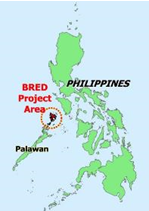On January 30th 2018, the final report on the feasibility of establishing a hybrid renewable energy facility (Solar-Biomass) on the Island of Busuanga was presented.
The final workshop illustrates the strong involvement of institutional partners at national (DENR, DOE, NEA) and local levels (Provincial Governement of Palawan, PSCD, Electric Cooperative BISELCO, mayors of municipalities of Coron and Busuanga), as well of operators and industrials (Green Missionary Energy, CIPC, Schneider Electric, Enertime, Enertech, Bocard, Solenergy, Sirea,…) that expressed interest for being part of the project.
This study was conducted between august 2015 and december 2017 by IED, with the financial support of the French Ministry of Finance (FASEP) for the DENR and managed by PCSD.
Tourism and industrial development have a major impact on increase in power demand in Busuanga. It is expected that energy demand will grow from 24 GWh in 2017 to 54 GWh in the year 2036, and peak load from 4.4 to 10.0 MW. The current installed capacity of the private power producer on the island, CIPC is 7,7 MW of HFO and 0,9 MW of diesel and will not be sufficient to meet demand within the next 5 years
The main activities performed by IED’s team consist of :
- Assess the future electricity demand using a disaggregated bottom up approach;
- Make a diagnosis of existing facilities and commitments
- Evaluate local potentials of renewable energy and the conditions for their uses;
- Identify technical solutions to achieve a high penetration rate of renewable energy;
- Assess the technical and economic feasibility of the proposed solutions;
- Carry out detailed studies of chosen plans;
- Evaluate the economic viability and develop an adapted business model for project developers.
Following the study of different scenarii for integrating the renewable energy in Busuanga’s energy mix, the optimized generation plan is based on “step by step” implementation strategy:
- Step 0: Reference scenario with only existing capacity
- Step 1: Installation of a LFO power plant of 1.25 MW in 2018, considering the imminent risk of outages
- Step 2: Installation of a 2.5 MWp added in 2019
- Step 3: Installation of a storage system of 1.5 MWh in 2019
- Step 4: PV and storage capacity double in 2023
- Step 5: Installation of a 2 MW biomass power plant in 2020
- Step 4: Biomass power plant capacity double in 2024
The proposed generation plan enables to achieve :
- High RE penetration (54% in average over a 20-year period)
- While improving system reliability, the cumulated shortage hours for 2018-2036 decreasing from 25 100 to 350 hours only)
- Without negative impact on overall production cost, with a slight decrease of the Levelized Cost of Energy (LCOE).
The implementation scheme for the Busuanga renewable energy hybrid is to set up a joint venture between BISELCO, the Electric Cooperative which would be the leader, Green Missionary Energy (GME) from the Association of Island Electric Cooperatives (AIEC), and IED- Invest (foreign and minority shareholder).
The current project offers high prospects for replication in the Philippines:
- The innovative hybrid scheme, with a “smart micro grid controller” offers potential for numerous islands in the country;
- Having dedicated plantations for a small biomass unit is a win-win, for the biomass power plant which controls its feedstock and for ensuring the sustainability of the reforestation scheme;
- A Public Private Partnership Joint Venture with an Electric Cooperative, which is a clear policy priority for NEA and DOE.
- Sustainable model for plantations projects made viable thanks to pellet exports.


